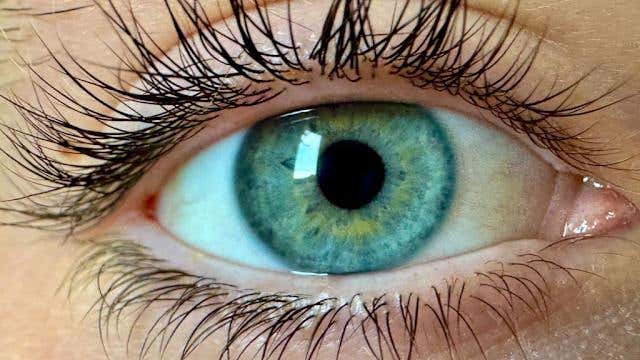Meet ‘Olo’: The vivid new color only five people have ever seen
Scientists use lasers to reveal a vivid new color, “olo,” never seen in nature and only visible by retinal stimulation.

A new blue-green color called “olo” has been discovered using lasers to target the eye’s M cone cells, expanding human color vision. (CREDIT: Getty Images)
A team of scientists has found a way to unlock a color that doesn't exist in the natural world. Named "olo," this new shade has only been seen by five people so far. It's described as a vivid blue-green, unlike anything your eyes could see on their own. But to witness it, you’d need a high-tech system that stimulates the retina in a way never done before.
The system, called Oz, lets researchers control how light hits individual cone cells in your eye—cell by cell. That means they can send messages to your brain that nature never intended, opening a door to a world of color perception that didn’t exist before.
Rewriting the Rules of Vision
Color vision begins with cones—light-sensitive cells in your retina. You have three types: S, M, and L cones, which respond to short, medium, and long wavelengths of light. These combine to give you your full range of color vision.
Normally, when one type of cone is stimulated, its neighbors are too. That overlap means your brain never gets a “pure” message from just one type of cone. But the Oz system breaks that rule. Using laser microdoses aimed precisely at the M cones, the system skips the L and S cones completely.
This triggers a kind of brain signal that never happens in natural vision. The result is a color that falls outside the boundaries of your normal visual world. It doesn't exist on any screen or paint palette. It’s called "olo," and it’s a color defined by pure M cone activation.
"Subjects report that olo appears blue-green of unprecedented saturation, when viewed relative to a neutral grey background," wrote the research team in their study published in Science Advances. To match it with a known color, people had to add white light until it looked pale enough to compare—a clear sign that it lies beyond the natural human gamut.
Related Stories
How Oz Brings Olo to Life
The Oz system is named in tribute to the green-tinted world of the Emerald City. Like Dorothy’s journey, this project reveals a hidden reality, one few ever expected to find. Developed by researchers at UC Berkeley and the University of Washington, Oz doesn’t use magic but lasers and real-time tracking.
To begin, scientists mapped the retina of each participant using adaptive optics optical coherence tomography (AO-OCT). This technology helped them identify which cones were L, M, or S. Each person’s retinal layout is unique, so the mapping is essential. Once mapped, the Oz system used adaptive optics scanning light ophthalmoscopy (AOSLO) to direct visible-wavelength lasers to individual cone cells, all while tracking natural eye movements.
It’s not easy. The eye is always in motion—even during focused vision. Oz had to fire thousands of laser pulses per second, adjusting for movement in real time. When done right, the participant saw olo. If the lasers missed—even by just a few microns—they saw ordinary green light instead.
"Let’s say you go around your whole life and you see only pastel pink," explained Professor Ren Ng from UC Berkeley. "And then one day you see something so deeply saturated, it redefines what pink can be. That’s what happened when we saw olo."
More Than Just a New Hue
Beyond the thrill of discovering a new color, the Oz system offers a powerful tool for science. It allows researchers to study how vision works at a new level of detail—controlling and observing responses from individual cone cells.
“We originally started this project specifically to study M cone stimulation,” said co-first author James Fong, a PhD student in computer science at Berkeley. “But it quickly became clear to us that the required underlying technology would be broadly useful to study visual function at a new level of scale and precision.”
The implications go far beyond discovering new colors. By precisely controlling stimulation patterns, Oz might help simulate the vision of people with different eye conditions, like color blindness or retinal degeneration. It could even explore how a fourth cone type—something found in rare tetrachromatic individuals—might work.
Fong noted that introducing the brain to unfamiliar patterns of stimulation could, in theory, teach people with color blindness to perceive new dimensions of color. “It may be possible that this person would learn to see the new dimension of color,” he said.
The Limits—and Future—of Oz
As exciting as this breakthrough is, Oz remains a lab-based tool for now. The current system is large, slow, and complex. Participants must stare at a fixed point because only a small region of the retina has been mapped for stimulation.
This means you can’t yet look directly at an Oz image. Your eye’s central region, where cones are packed tightly for sharp vision, is just too small for current laser precision. Scientists had participants focus slightly off-center and use their peripheral vision to see olo.
Also, expanding the field of view would require mapping far more cones across the retina and tracking eye movements at even higher resolution. These are big challenges. So don’t expect to see olo on your phone or TV anytime soon.
"These lasers and optics are definitely not coming to smartphones or TVs any time soon," Fong confirmed.
Still, the team believes Oz has plenty of potential in medical research. It’s already being used to explore how the brain processes vision and how diseases change that process. Scientists are also working to model how visual loss happens and might even design ways to reverse or prevent it.
A Color That’s More Than Visual
Not everyone is convinced this is truly a "new" color. Vision scientist John Barbur from City St George’s, University of London, called it a "more saturated green" rather than something fundamentally different. “It’s not a new color,” he argued. “It can only be produced in a subject with normal red-green chromatic mechanism when the only input comes from M cones.”
But even critics agree that Oz represents a major technological feat. The ability to selectively stimulate cone cells at this scale and duration was thought to be out of reach just a few years ago.
As for olo, it might not be as revolutionary as red or blue once seemed—but to the five people who’ve seen it, it's unforgettable.
“There’s no color like olo,” wrote one journalist. And maybe that’s true. Just like the land of Oz, this new color doesn’t show up on any map. But it exists—at least for now—at the edge of what your eyes and brain can understand.
Note: The article above provided above by The Brighter Side of News.
Like these kind of feel good stories? Get The Brighter Side of News' newsletter.
Rebecca Shavit
Science & Technology Journalist | Innovation Storyteller
Based in Los Angeles, Rebecca Shavit is a dedicated science and technology journalist who writes for The Brighter Side of News, an online publication committed to highlighting positive and transformative stories from around the world. With a passion for uncovering groundbreaking discoveries and innovations, she brings to light the scientific advancements shaping a better future. Her reporting spans a wide range of topics, from cutting-edge medical breakthroughs and artificial intelligence to green technology and space exploration. With a keen ability to translate complex concepts into engaging and accessible stories, she makes science and innovation relatable to a broad audience.



